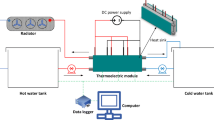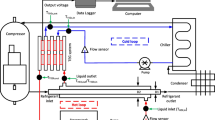Abstract
Thermoelectric coolers are preferred in many areas because of their simple mechanism and no need for a refrigerant. In this study, an air-to-water mini thermoelectric cooler system was designed and produced. Experiments were performed by placing different numbers of thermoelectric modules on the liquid-cooling heat sink and applying different voltages. The cooling capacity and COP values of the system under different operating conditions were analyzed and discussed. In addition, the effect of fluid flow rate on system performance and temperature difference between inlet and outlet sections has been presented. The heat transfer and flow behavior of the fluid in the liquid-cooling heat sink were determined using CFD simulation methods. Moreover, the heat loss from the system was tried to be reduced by using extra foam insulation and the results were compared with single foam and the effect of the insulation on the temperature drop inside cooler was discussed. At 0.011 kg s−1 mass flow rate and 12 V voltage conditions, when the number of TE modules is increased from 1 to 3 in the TE cooler, a maximum increase of 35% in cooling load is obtained. Also, if the cases with 3 TE modules and 0.011 kg s−1 flow rate are compared in terms of cooling load, 12 V has 80% higher cooling load than 4 V. According to the numerical results, flow structures that negatively affect the heat transfer interactions and reduce the cooling performance of the TE cooler have been determined in the liquid-cooled heat exchanger. Additionally, a significant decrease in the temperature of the cooling chamber has also been achieved with additional insulation.




















Similar content being viewed by others
Abbreviations
- COP:
-
Coefficient of performance
- CFD:
-
Computational fluid dynamics
- TE:
-
Thermoelectric
- P:
-
Peltier
- µ :
-
Dynamic viscosity (kg m−1 s−1)
- µ t :
-
Turbulent viscosity (kg m−1 s−1)
- ∀:
-
Volume (m3)
- C µ :
-
Turbulence constant
- C p :
-
Specific heat capacity (J kg−1 K−1)
- G k :
-
Generation of turbulent kinetic energy
- I :
-
Electric current (A)
- k :
-
Thermal conductivity (W m−1 K−1)
- m :
-
Mass (kg)
- Q c :
-
Cooling load (J)
- T :
-
Temperature (°C)
- t :
-
Time (s)
- V :
-
Voltage (V)
- v :
-
Velocity (m s−1)
- W :
-
Power consumption (W)
- ϵ :
-
Turbulent dissipation rate (m2 s−3)
- ρ :
-
Density (kg m−1)
- a:
-
Air
- f:
-
Final
- i:
-
Initial
References
Mao J, Chen G, Ren Z. Thermoelectric cooling materials. Nat Mater. 2021;20(4):454–61.
Enescu D, Virjoghe EO. A review on thermoelectric cooling parameters and performance. Renew Sustain Energy Rev. 2014;38:903–16.
Zhao D, Tan G. A review of thermoelectric cooling: materials, modeling and applications. Appl Therm Eng. 2014;66(1–2):15–24.
Sahoo RR, Srivastava K. Performance assessment of a new energy harvesting system using thermoelectric generator coupled with solar radiation on hybrid nanofluids. J Therm Anal Calorim. 2022;147(21):12269–84.
Dresselhaus MS, Chen G, Tang MY, Yang RG, Lee H, Wang DZ, Ren Z, Fleurial JP, Gogna P. New directions for low-dimensional thermoelectric materials. Adv Mater. 2007;19(8):1043–53.
Hand CT, Peuker S. An experimental study of the influence of orientation on water condensation of a thermoelectric cooling heatsink. Heliyon. 2019;5(10):e02752.
Al-Shehri S, Saber HH. Experimental investigation of using thermoelectric cooling for computer chips. J King Saud Univ Eng Sci. 2020;32(5):321–9.
Putra N, Iskandar FN. Application of nanofluids to a heat pipe liquid-block and the thermoelectric cooling of electronic equipment. Exp Therm Fluid Sci. 2011;35(7):1274–81.
Liu D, Zhao FY, Yang HX, Tang GF. Thermoelectric mini cooler coupled with micro thermosiphon for CPU cooling system. Energy. 2015;83:29–36.
Liu D, Cai Y, Zhao FY. Optimal design of thermoelectric cooling system integrated heat pipes for electric devices. Energy. 2017;128:403–13.
Lyu Y, Siddique ARM, Gadsden SA, Mahmud S. Experimental investigation of thermoelectric cooling for a new battery pack design in a copper holder. Results Eng. 2021;10:100214.
Lyu Y, Siddique ARM, Majid SH, Biglarbegian M, Gadsden SA, Mahmud S. Electric vehicle battery thermal management system with thermoelectric cooling. Energy Rep. 2019;5:822–7.
Moazzez AF, Najafi G, Ghobadian B, Hoseini SS. Numerical simulation and experimental investigation of air cooling system using thermoelectric cooling system. J Therm Anal Calorim. 2020;139(4):2553–63.
Duan M, Sun H, Lin B, Wu Y. Evaluation on the applicability of thermoelectric air cooling systems for buildings with thermoelectric material optimization. Energy. 2021;221:119723.
Ismaila KG, Sahin AZ, Yilbas BS, Al-Sharafi A. Thermo-economic optimization of a hybrid photovoltaic and thermoelectric power generator using overall performance index. J Therm Anal Calorim. 2021;144:1815–29.
Benghanem M, Al-Mashraqi AA, Daffallah KO. Performance of solar cells using thermoelectric module in hot sites. Renew Energy. 2016;89:51–9.
Singh D, Chaubey H, Parvez Y, Monga A, Srivastava S. Performance improvement of solar PV module through hybrid cooling system with thermoelectric coolers and phase change material. Sol Energy. 2022;241:538–52.
Cheng TC, Cheng CH, Huang ZZ, Liao GC. Development of an energy-saving module via combination of solar cells and thermoelectric coolers for green building applications. Energy. 2011;36(1):133–40.
Wan QS, Su JJ, Huang YY, Wang YP, Liu X. Numerical and experimental investigation on symmetrical cross jet of localized air conditioning system with thermoelectric cooling devices in commercial vehicles. Int J Refrig. 2022;140:29–38.
Wan Q, Deng Y, Su C, Wang Y. Optimization of a localized air conditioning system using thermoelectric coolers for commercial vehicles. J Electron Mater. 2017;46(5):2990–8.
Yang J, Stabler FR. Automotive applications of thermoelectric materials. J Electron Mater. 2009;38(7):1245.
Afshari F, Ceviz MA, Mandev E, Yıldız F. Effect of heat exchanger base thickness and cooling fan on cooling performance of air-to-air thermoelectric refrigerator; experimental and numerical study. Sustain Energy Technol Assess. 2022;52:102178.
Abdul-Wahab SA, Elkamel A, Al-Damkhi AM, Is’haq A, Al-Rubai’ey HS, Al-Battashi AK, Al-Tamimi AR, Al-Mamari H, Chutani MU. Design and experimental investigation of portable solar thermoelectric refrigerator. Renew Energy. 2009;34(1):30–4.
Manikandan S, Selvam C, Praful PPS, Lamba R, Kaushik SC, Zhao D, Yang R. A novel technique to enhance thermal performance of a thermoelectric cooler using phase-change materials. J Therm Anal Calorim. 2020;140:1003–14.
Astrain D, Aranguren P, Martínez A, Rodríguez A, Pérez MG. A comparative study of different heat exchange systems in a thermoelectric refrigerator and their influence on the efficiency. Appl Therm Eng. 2016;103:1289–98.
Sarkar A, Mahapatra SK. Role of surface radiation on the functionality of thermoelectric cooler with heat sink. Appl Therm Eng. 2014;69(1–2):39–45.
Baldry M, Timchenko V, Menictas C. Optimal design of a natural convection heat sink for small thermoelectric cooling modules. Appl Therm Eng. 2019;160:114062.
He B, Chen W, Tan X, Lu S, Zhang J, Li X. Investigation of natural convection characteristics in the molding chamber of a 3-D printer cooled by thermoelectric cooling modules. Int J Mech Sci. 2022;224:107315.
He RR, Zhong HY, Cai Y, Liu D, Zhao FY. Theoretical and experimental investigations of thermoelectric refrigeration box used for medical service. Procedia Eng. 2017;205:1215–22.
Çağlar A. Optimization of operational conditions for a thermoelectric refrigerator and its performance analysis at optimum conditions. Int J Refrig. 2018;96:70–7.
Vian JG, Astrain D. Development of a heat exchanger for the cold side of a thermoelectric module. Appl Therm Eng. 2008;28(11–12):1514–21.
Ceviz MA, Afshari F, Muratçobanoğlu B, Ceylan M, Manay E. Computational fluid dynamics simulation and experimental investigation of a thermoelectric system for predicting influence of applied voltage and cooling water on cooling performance. Int J Numer Methods Heat Fluid Flow. 2022;33(1):241–62.
Martínez A, Astrain D, Rodríguez A, Pérez G. Reduction in the electric power consumption of a thermoelectric refrigerator by experimental optimization of the temperature controller. J Electron Mater. 2013;42(7):1499–503.
Siahmargoi M, Rahbar N, Kargarsharifabad H, Sadati SE, Asadi A. An experimental study on the performance evaluation and thermodynamic modeling of a thermoelectric cooler combined with two heatsinks. Sci Rep. 2019;9(1):1–11.
Riffat SB, Omer SA, Ma X. A novel thermoelectric refrigeration system employing heat pipes and a phase change material: an experimental investigation. Renew Energy. 2001;23(2):313–23.
Afshari F. Experimental and numerical investigation on thermoelectric coolers for comparing air-to-water to air-to-air refrigerators. J Therm Anal Calorim. 2021;144(3):855–68.
Chavan P, Sidhu GK, Alam MS, Kumar M. Mathematical design and performance investigation of evaporator water cooled storage-cum-mobile thermoelectric refrigerator for preservation of fruits and vegetables. J Food Process Eng. 2021;44(8):13770.
Cuce E, Guclu T, Cuce PM. Improving thermal performance of thermoelectric coolers (TECs) through a nanofluid driven water to air heat exchanger design: An experimental research. Energy Convers Manag. 2020;214:112893.
Gökçek M, Şahin F. Experimental performance investigation of minichannel water cooled-thermoelectric refrigerator. Case Stud Therm Eng. 2017;10:54–62.
Vián JG, Astrain D. Development of a thermoelectric refrigerator with two-phase thermosyphons and capillary lift. Appl Therm Eng. 2009;29(10):1935–40.
Min G, Rowe DM. Experimental evaluation of prototype thermoelectric domestic-refrigerators. Appl Energy. 2006;83(2):133–52.
Rahman SMA, Hachicha AA, Ghenai C, Saidur R, Said Z. Performance and life cycle analysis of a novel portable solar thermoelectric refrigerator. Case Stud Therm Eng. 2020;19:100599.
Abderezzak B, Dreepaul RK, Busawon K, Chabane D. Experimental characterization of a novel configuration of thermoelectric refrigerator with integrated finned heat pipes. Int J Refrig. 2021;131:157–67.
Mirmanto M, Syahrul S, Wirdan Y. Experimental performances of a thermoelectric cooler box with thermoelectric position variations. Eng Sci Technol Int J. 2019;22(1):177–84.
Ohara B, Sitar R, Soares J, Novisoff P, Nunez-Perez A, Lee H. Optimization strategies for a portable thermoelectric vaccine refrigeration system in developing communities. J Electron Mater. 2015;44(6):1614–26.
Jugsujinda S, Vora-ud A, Seetawan T. Analyzing of thermoelectric refrigerator performance. Procedia Eng. 2011;8:154–9.
Tamami F, Doyan A, Ayub S, Hudha LS. Designing and constructing mini refrigerator with thermoelectric module. J Phys Conf Ser. 2022;2165:012032.
Hermes CJ, Barbosa JR. Thermodynamic comparison of Peltier, Stirling, and vapor compression portable coolers. Appl Energy. 2012;91(1):51–8.
Park H, Lee J, Lim J, Cho H, Kim J. Optimal operating strategy of ash deposit removal system to maximize boiler efficiency using CFD and a thermal transfer efficiency model. J Ind Eng Chem. 2022;110:301–17.
Afshari F, Mandev E, Rahimpour S, Muratçobanoğlu B, Şahin B, Manay E, Teimuri-Mofrad R. Experimental and numerical study on air-to-nanofluid thermoelectric cooling system using novel surface-modified Fe3O4 nanoparticles. Microfluid Nanofluid. 2023;27(4):26.
Afshari F, Zavaragh HG, Sahin B, Grifoni RC, Corvaro F, Marchetti B, Polonara F. On numerical methods; optimization of CFD solution to evaluate fluid flow around a sample object at low Re numbers. Math Comput Simul. 2018;152:51–68.
Afshari F, Tuncer AD, Sözen A, Variyenli HI, Khanlari A, Gürbüz EY. A comprehensive survey on utilization of hybrid nanofluid in plate heat exchanger with various number of plates. Int J Numer Methods Heat Fluid Flow. 2021;32(1):241–64.
Güngör A, Khanlari A, Sözen A, Variyenli HI. Numerical and experimental study on thermal performance of a novel shell and helically coiled tube heat exchanger design with integrated rings and discs. Int J Therm Sci. 2022;182:107781.
Acknowledgements
This study was financially supported by Research Project Foundation of the Erzurum Technical University (BAP Project No. 2020/10). The authors gratefully acknowledge this support.
Funding
Erzurum Technical University (BAP-2020/10).
Author information
Authors and Affiliations
Corresponding author
Ethics declarations
Conflict of interest
The authors declare that they have no conflict of interest.
Additional information
Publisher's Note
Springer Nature remains neutral with regard to jurisdictional claims in published maps and institutional affiliations.
Rights and permissions
Springer Nature or its licensor (e.g. a society or other partner) holds exclusive rights to this article under a publishing agreement with the author(s) or other rightsholder(s); author self-archiving of the accepted manuscript version of this article is solely governed by the terms of such publishing agreement and applicable law.
About this article
Cite this article
Muratçobanoğlu, B., Mandev, E., Ceviz, M.A. et al. CFD simulation and experimental analysis of cooling performance for thermoelectric cooler with liquid cooling heat sink. J Therm Anal Calorim 149, 359–377 (2024). https://doi.org/10.1007/s10973-023-12682-4
Received:
Accepted:
Published:
Issue Date:
DOI: https://doi.org/10.1007/s10973-023-12682-4




